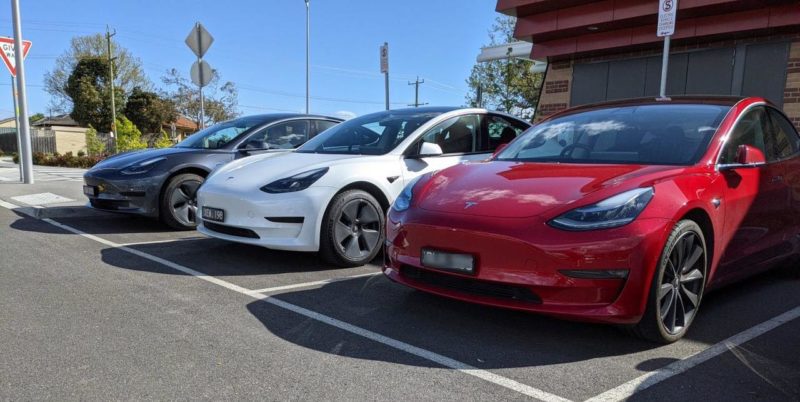Tesla chair Robyn Denholm has flagged a phenomenal jump in the number of the company’s electric vehicles on Australian roads, saying the number could double to more than 50,000 vehicles by the end of the year.
The comments by Denholm suggest that orders for the popular Model Y electric crossover are running ahead of even the most optimistic forecasts, and suggests a huge leap in the last two quarters after a big slump in the last three months due to Covid impacts of its Shanghai gigafactory.
Denholm, speaking on Tuesday morning at the Australian Clean Energy Summit, gave a rare insight to the number of electric vehicles the US company currently has on Australian roads, confirming that the current total – mostly Model 3 electric sedans – is around 27,000.
“Tesla’s local vehicle fleet has … grown from a low base, to where we we now have more than 26,500 Tesla’s on Australian roads, and the momentum is there. I personally wouldn’t be surprised if we … double that number by the end of the year,” she told the conference.
The Model Y has only recently been open for orders in Australia, and The Driven reported that more than 12,000 Model Ys had been ordered in the first weekend. That number appears to have grown again, although many have been told that their car may not arrive until early 2023.
But Denholm stressed that this possible doubling of the national Tesla EV fleet was in the context of Australia’s “very unique position” of having more Powerwall home batteries installed than Teslas on the road – a legacy of the complete lack of federal policy support for EV uptake in the past decade.
“Australia is behind on the shift to electric vehicles and the electrification of transportation. Today, electric vehicles make up just 2% of the new car market. And that’s largely because we’re one of the only OECD countries with no fuel efficiency standards,” she said.
Australia’s track record on fuel efficiency, or vehicle emissions, standards – broadly considered to be the easiest and smartest policy to encourage the shift to electric vehicles – has been characterised by a distinct lack of political backbone.
As The Driven has reported, former federal Treasurer Josh Frydenberg raised the idea of vehicle emission standards several years ago, before dumping it after a Murdoch tabloid branded the measure a “carbon tax on wheels.”
And in the lead-up to the May federal election, Labor, too, proved not brave enough to prosecute a policy on vehicle emissions, for fear of unleashing a political scare campaign that might, for a second time, derail its hopes of winning government.
Now safely in government, Labor’s federal climate and energy minister Chris Bowen has gone only as far as to “not rule out” the introduction of vehicle emissions standards.
In an address to the National Press Club last month, Bowen said the new Albanese government would consider “all viable options” to expand support for electric vehicles.
“We have an electric vehicle strategy, which we will now develop in office… and we’ll consider further policy options to add to and build on what we’ve already committed to,” he said.
But Denholm says the introduction of a national emissions standard for vehicles in Australia is a non-negotiable if the country can have any hope of meeting its newly ratcheted-up targets for emissions reduction.
“Australia currently accepts vehicles that the rest of the world doesn’t. They’re either too dirty or expensive to run.
“We’ve seen state governments starting to lead the way but without national standards progress will be held back.
“It’s time for fuel efficiency standards in Australia, and they must be strong standards. I’m hopeful that the new federal government will bring Australia up to par.”
Denholm points to Australia’s nearest neighbour, New Zealand, as a good benchmark for the sort of policy and standards that should be in place.
“Until recently New Zealand was in a very similar position to Australia, but they passed two excellent laws,” she said.
“The first was the clean car discount scheme, which has been in operation for just over a year. And the EV sales have nearly tripled.
“The second is sensible fuel efficiency standards, which begin in earnest next year. And we’ll see them catch up to Europe and other markets within six years.”
Beyond a vehicle emissions standard, Denholm says Australia also needs to ramp up its support for the build-out of EV infrastructure, in particular fast charging stations.
Again, she points at examples from overseas, including California, where they have targeted the construction of 1.2 million charging stations by 2030 and backed up that target with a streamlined permitting process.
“Tesla’s ambition is to triple the supercharging network in the next two years and the EV charging industry here in Australia is ready to make significant investments in building charging infrastructure,” she told the conference.
Denholm says it’s not just a lack of supporting policy or investment that is hindering the rollout of fast chargers in Australia, but also a failure of regulatory, permitting and logistical processes – a complaint also shared by large-scale solar, wind and battery energy storage developers.
“We have the equipment, the capital, and increasingly the customers but we’re being held back. Fast charging stations require upgrades to transformers on the energy grid,” she said.
“It isn’t complicated from a technology point of view. The steps are known and it takes technicians just a few days. But currently it can take over a year from application to grid connection. That’s four times longer than anywhere else in the region.
“To serve the growing number of EVs on the roads that need charging … these charges need to be rolled out without delay. This is missing the missing piece to mass EV adoption.”

Sophie is editor of One Step Off The Grid and deputy editor of its sister site, Renew Economy. Sophie has been writing about clean energy for more than a decade.

